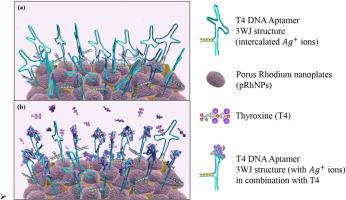Colloids and Surfaces B: Biointerfaces ( IF 5.4 ) Pub Date : 2020-07-02 , DOI: 10.1016/j.colsurfb.2020.111240 Sun Yong Park 1 , Jinmyeong Kim 1 , Gyeonghye Yim 2 , Hongje Jang 2 , Yeonju Lee 1 , Soo Min Kim 1 , Chulhwan Park 1 , Min-Ho Lee 3 , Taek Lee 1

|
Thyroxine (T4) contains four iodine atoms and is a major thyroid hormone synthesized in the thyroid gland. Abnormal levels of T4 in the body cause various endocrine diseases. The present study describes the fabrication of an electrochemical biosensor composed of a multi-functional DNA structure/rhodium nanoplates heterolayer for precise detection of T4 concentration. A DNA 3-way junction (3WJ) structure was designed as a multi-functional bioprobe to perform several functions (including target detection, electrochemical signal reporting, and immobilization) simultaneously. Binding between T4 and the T4 DNA aptamer was confirmed through enzyme-linked aptamer assays (ELAAs) and filtration experiments. The multi-functional DNA was immobilized on porous rhodium nanoplates (pRhNPs)-heterolayer modified Au micro-gap electrode. The pRhNPs provided an increment in the surface area and amplification of the electrochemical signal. Cyclic voltammetry (CV) and electrochemical impedance spectroscopy (EIS) were used to detect T4. Under optimal conditions, the limit of detection of T4 was found to be 10.33 pM. Furthermore, up to 11.41 pM of T4 could be detected in clinical samples. This study demonstrates the possibility of label-free detection of the T4 with multi-functional DNA/pRhNPs heterolayer that can be applied to small molecule detection platform in the near future.
中文翻译:

由多功能DNA/铑纳米板异层组成的电化学生物传感器的制备用于临床样品中甲状腺素的检测。
甲状腺素 (T4) 包含四个碘原子,是在甲状腺中合成的主要甲状腺激素。体内T4水平异常会导致各种内分泌疾病。本研究描述了由多功能 DNA 结构/铑纳米板异层组成的电化学生物传感器的制造,用于精确检测 T4 浓度。DNA 3 路连接 (3WJ) 结构被设计为多功能生物探针,可同时执行多种功能(包括目标检测、电化学信号报告和固定)。T4 和 T4 DNA 适体之间的结合通过酶联适体测定 (ELAA) 和过滤实验得到证实。多功能 DNA 固定在多孔铑纳米板 (pRhNPs)-杂层修饰的 Au 微间隙电极上。pRhNPs 提供了表面积的增加和电化学信号的放大。循环伏安法 (CV) 和电化学阻抗谱 (EIS) 用于检测 T4。在最佳条件下,发现 T4 的检测限为 10.33 pM。此外,在临床样本中可以检测到高达 11.41 pM 的 T4。这项研究证明了在不久的将来可以应用于小分子检测平台的多功能 DNA/pRhNPs 杂层对 T4 进行无标记检测的可能性。在临床样品中可以检测到 41 pM 的 T4。这项研究证明了在不久的将来可以应用于小分子检测平台的多功能 DNA/pRhNPs 杂层对 T4 进行无标记检测的可能性。在临床样品中可以检测到 41 pM 的 T4。这项研究证明了在不久的将来可以应用于小分子检测平台的多功能 DNA/pRhNPs 杂层对 T4 进行无标记检测的可能性。











































 京公网安备 11010802027423号
京公网安备 11010802027423号